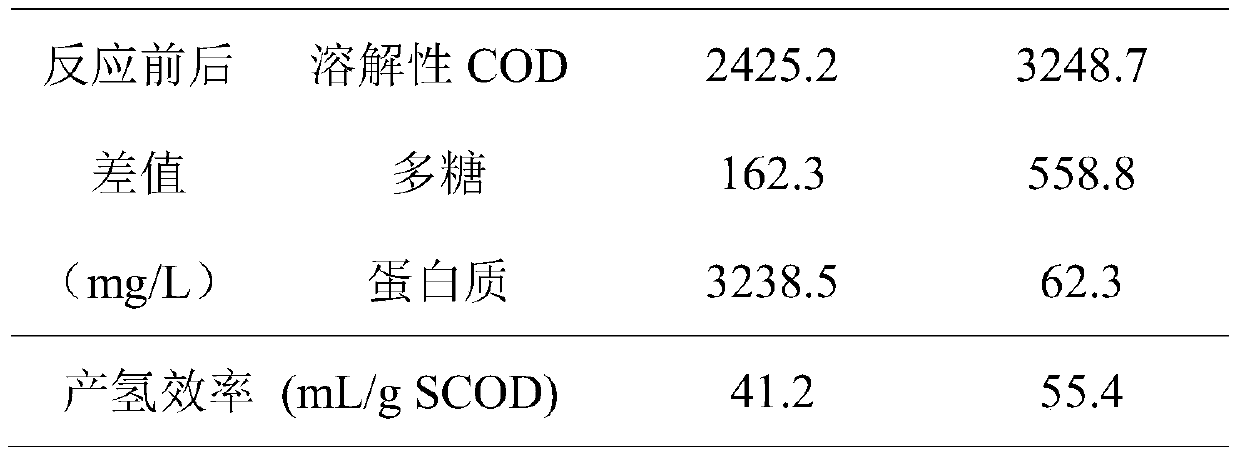A method for decomposing excess sludge in sewage treatment plants and its application in biological hydrogen production
A technology for biological hydrogen production and excess sludge, which is applied in the oxidation treatment of sludge, water treatment parameter control, water/sludge/sewage treatment, etc. Effectively solve problems such as reducing costs and efficiently producing hydrogen
- Summary
- Abstract
- Description
- Claims
- Application Information
AI Technical Summary
Problems solved by technology
Method used
Image
Examples
Embodiment 1
[0019] Example 1: The effect of low temperature wet oxidation method to crack sludge
[0020] Put 400mL of excess sludge in a 500mL stainless steel tank generator, seal it, heat it to 160-180°C, and keep it for 30min, during which it is cooled by a circulating water bath to control the reaction temperature. After 30 minutes, remove the electric furnace, let the kettle generator cool down to room temperature naturally, open it, and take out the treated sludge. The properties of the sludge mixture were analyzed, and the results showed that the soluble COD of the sludge mixture was 10914mg / L, which was 32.8 times higher than that of the original sludge.
Embodiment 2
[0021] Example 2: Hydrogen production effect of cracked sludge mixture obtained by low temperature wet oxidation method
[0022] 1L of anaerobic digested sludge taken from the primary digester of a sewage treatment plant is placed in a 1L brown ground-mouth bottle, and is irradiated with gamma rays at a dose of 5kGy at room temperature to inhibit hydrogen-phagocytic bacteria and retain hydrogen-producing bacteria , the radioactive source is 60 Co. The treated inoculum sludge was stored at -80°C, and was taken out and thawed when inoculation was needed.
[0023] Take 80mL of the original sludge mixture and cracked sludge mixture, put them in 150mL conical flasks respectively, inoculate 10mL of irradiated anaerobic digested sludge into the two groups of sludge mixtures, and add 10mL of nutrients solution, so that the total reaction volume was 100 mL. Before the reaction, use 5mol / L hydrochloric acid or 5mol / L sodium hydroxide solution to adjust the initial pH of the reaction ...
Embodiment 3
[0027] Example 3: The effect of adding glucose on the hydrogen production effect of cracked sludge as a substrate fermentation
[0028] Put 400mL of excess sludge into a 500mL stainless steel tank generator and seal it. Heated to 175°C and kept for 30min, during which the reaction temperature was controlled at 175°C by cooling in a circulating water bath. After 30 minutes, remove the electric furnace, let the kettle generator cool down to room temperature naturally, open it, and take out the cracked sludge mixture.
[0029] Take 1L of anaerobic digested sludge and place it in a 1L brown ground-mouth bottle, and accept γ-ray irradiation with a radiation dose of 5kGy at room temperature, and the radioactive source is 60 Co.
[0030] Take 80mL of the original sludge mixture and cracked sludge mixture, put them in 150mL conical flasks respectively, inoculate 10mL of irradiated anaerobic digested sludge into the two groups of sludge mixtures, and add 10mL of nutrients solution, ...
PUM
| Property | Measurement | Unit |
|---|---|---|
| solubility (mass) | aaaaa | aaaaa |
Abstract
Description
Claims
Application Information
 Login to View More
Login to View More - R&D
- Intellectual Property
- Life Sciences
- Materials
- Tech Scout
- Unparalleled Data Quality
- Higher Quality Content
- 60% Fewer Hallucinations
Browse by: Latest US Patents, China's latest patents, Technical Efficacy Thesaurus, Application Domain, Technology Topic, Popular Technical Reports.
© 2025 PatSnap. All rights reserved.Legal|Privacy policy|Modern Slavery Act Transparency Statement|Sitemap|About US| Contact US: help@patsnap.com


